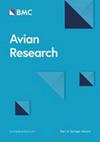鸟类监测中的eDNA技术综述:现状、挑战与展望
IF 1.7
2区 生物学
Q1 ORNITHOLOGY
引用次数: 0
摘要
近年来,环境DNA (environmental DNA, eDNA)作为一种新型的生物多样性监测工具,因其高效、便捷和非侵入性而受到广泛关注。尽管它广泛应用于各种生态研究,如保护、入侵生物学、生物监测和生物多样性调查评估,但它在鸟类监测中的应用仍处于起步阶段。这篇综述严格审查了鸟类监测中eDNA技术的潜力和局限性,重点关注了这一新兴领域的当前进展和持续挑战。水和空气是收集鸟类eDNA的主要环境介质,尽管也探索了其他来源,如蜘蛛网和植物花。值得注意的是,据报道,空气中的eDNA捕获了鸟类物种的最高多样性。虽然鸟类eDNA技术在监测稀有和濒危物种以及评估鸟类多样性方面显示出了希望,但仍存在重大挑战,特别是在采样策略、DNA提取方法、引物选择和确定丰度方面。此外,我们还讨论了影响鸟类eDNA在环境中产生、运输和降解的因素。最后,我们提出了未来的研究方向,包括优化采样策略,开发鸟类特异性通用引物,扩展鸟类DNA条形码数据库,提高eDNA的可检测性,以及整合环境RNA (eRNA)和eDNA方法。本文章由计算机程序翻译,如有差异,请以英文原文为准。
A review of eDNA technology in avian monitoring: Current status, challenges and future perspectives
In recent years, environmental DNA (eDNA) has garnered significant attention as a novel tool in biodiversity monitoring, recognized for its efficiency, convenience, and non-invasiveness. Despite its extensive application in various ecological studies, such as conservation, invasion biology, biomonitoring and biodiversity survey assessment, its use in avian monitoring remains in its infancy. This review critically examines the potential and limitations of eDNA technology for avian monitoring, focusing on current advancements and ongoing challenges in this emerging field. Water and air are the primary environmental media for collecting avian eDNA, although other sources like spider webs and plant flowers have been explored as well. Notably, airborne eDNA has been reported to capture the highest diversity of avian species. While avian eDNA technology has shown promise for monitoring rare and endangered species and assessing avian diversity, significant challenges remain, particularly in sampling strategies, DNA extraction methodology, primer selection, and ascertain abundance. Additionally, we discussed the factors influencing the production, transportation, and degradation of avian eDNA in the environment. Finally, we suggested future research directions, including optimizing sampling strategies, developing avian-specific universal primers, expanding avian DNA barcode databases, enhancing eDNA detectability, and integrating environmental RNA (eRNA) and eDNA approaches.
求助全文
通过发布文献求助,成功后即可免费获取论文全文。
去求助
来源期刊

Avian Research
ORNITHOLOGY-
CiteScore
2.90
自引率
16.70%
发文量
456
审稿时长
46 days
期刊介绍:
Avian Research is an open access, peer-reviewed journal publishing high quality research and review articles on all aspects of ornithology from all over the world. It aims to report the latest and most significant progress in ornithology and to encourage exchange of ideas among international ornithologists. As an open access journal, Avian Research provides a unique opportunity to publish high quality contents that will be internationally accessible to any reader at no cost.
 求助内容:
求助内容: 应助结果提醒方式:
应助结果提醒方式:


